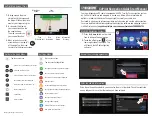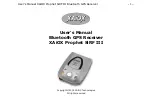
11
Document MT0605P.2018.E
© Xsens Technologies B.V.
MTi User Manual
1. The magnitude of the vibration is larger than the measurement range of the accelerometer. This
will cause the accelerometer to saturate, which may be observed as a “drift” in the zero-level of
the accelerometer. This will show up as an erroneous roll/pitch.
2. The frequency of the vibration is higher than the bandwidth of the accelerometer. In theory, such
vibrations are rejected, but in practice they can still give rise to aliasing, especially if close to the
bandwidth limit. This can be observed as a low frequency oscillation. Further, high frequency
vibrations often tend to have large acceleration amplitudes (see item 1).
There is an effect on the gyroscopes as well and especially when the vibrations include high-frequent
coning motion, the gyroscope readings may become invalid. The MTi 100-series features mechanical
vibration rejecting gyroscopes, designed to better cope with these specific conditions.
Note that the moving part on the Fischer connector can move to enable mating and unmating of the
cable with the MTi. The ring behind the moving part must be locked to prevent vibrations of the moving
parts of the connector to be transferred to the casing of the MTi.
Xsens has tested a set of vibration dampeners on the MTi. Vibration dampeners are low-profile rubber
cylinders that allow the MTi to be mounted on an object without a direct metal to metal connection that
transduces vibrations from the object to the MTi. The vibration dampeners have been tested with
frequencies up to 1200 Hz that caused aliasing when the MTi was mounted directly on the vibration
table had no effect with the vibration dampeners fitted. The dampeners tested are manufactured by
Norelem and have part number 26102-00800855,
3.5.3 Magnetic materials and magnets
When an MTi is placed close to or on an object that is either magnetic or contains ferromagnetic
materials, the measured magnetic field is distorted (warped) and causes an error in the computed yaw.
The earth magnetic field is altered by the presence of ferromagnetic materials, permanent magnets or
power lines with strong currents (several amperes) in the vicinity of the device. The distance to the object
and the amount of ferromagnetic material determines the magnitude of disturbance introduced. Errors
in estimated yaw due to such distortions can be quite large, since the earth magnetic field is very weak
in comparison to the magnitude of the sources of distortion.
For more information on how to mitigate the detrimental effects of magnetic distortion, refer to this BASE
article:
https://base.xsens.com/hc/en-us/articles/115004479409
3.6 Typical User Scenarios
This section is intended to help you find the right software component and corresponding documentation
for the way you want to use your MTi.
3.6.1 MT Software Suite
The MT Software Suite is a set of software components that can be used to communicate with the MTi
and to perform more high-level routines, such as logging, exporting, a magnetic field calibration and
updating of the firmware. Depicted in Figure 6 is a flow chart based on the software platform and the
preferred interface level.
On the left, three programs with GUIs are shown (Firmware Updater, Magnetic Field Mapper and MT
Manager). These programs offer the possibility to configure the MTi in a very easy way. The MT Manager
can also be used to communicate with the MTi. The MagField Mapper is also available as an SDK for
integration into another application.
The MT SDK contains all the developer code, such as a DLL, a shared object and basic functionality in
source code for embedded systems. Of course, it is possible to use lower level communication options,
















































